Sponsored by Takachiho Tourist Association
While Takachiho is mainly known for its sumptuous gorges and wagyu beef, Japanese mythology lovers will be delighted to spend a night there to attend the Takachiho Kagura, a famous Shinto ritual performance, which began in the village.
Takachiho Kagura
Kagura, written in kanji as 神楽, means “kami having fun” (a kami is a deity or a spirit worshipped by Shintoists). It is an artistic ritual consisting of a theatrical dance accompanied by traditional drum and flute music, performed by 3 musicians. The staging, the costumes, the scenery, and the traditional objects, are entirely made by the villagers.
The Kagura aims to thank the Kami who lives in the Shinto shrine of the village, for the good harvest of the year and to ask him for an even more plentiful one next year. In Japan, many villages have passed down the Kagura tradition for several centuries, but Tachiho is the best place to attend it since this dance originated in the village (since the 12th century!)
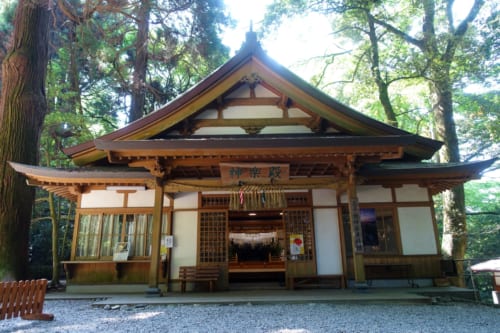
Summary of the story
The Kagura tells the Japanese folktale of the sun goddess Amaterasu, which is related in Kojiki and Nihon Shoki, two historical works of the 8th century.
This legend says that Amaterasu was so upset by the violent antics of her brother, the god of storms, that she fled to a cave, plunging the world into darkness.
All the deities of the Pantheon gathered together to find a way to get her out of the cave. Finally, another goddess, Ame-no-Uzume, performed a hilarious dance (some sources also say it was a striptease) and the laughter of the deities made such a noise that Amaterasu emerged to see what it was all about. The world was once again illuminated by her radiance. It is said that the cave where Amaterasu took refuge is in the village of Takachiho.
A theatrical dance in four acts
The Kagura is generally composed of 33 acts and lasts all night which one can attend between November and February. However, the 4 main acts are performed year round from 8 PM to 9 PM at Takachiho Shrine.
The first act is the Dance of Tajikarao, another deity, who represents her when she seeks Amaterasu and tries to hear the slightest noise indicating her presence.
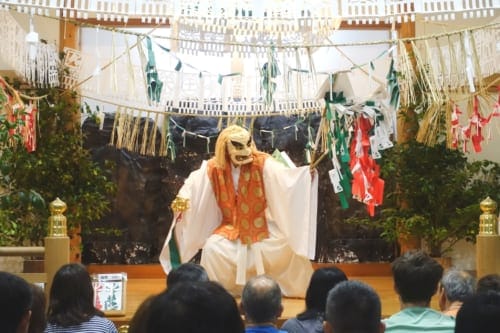
The second act is the Uzume Dance, the humorous dance performed by the goddess Uzume in front of the cave where the sun goddess is hiding in an attempt to lure her out.
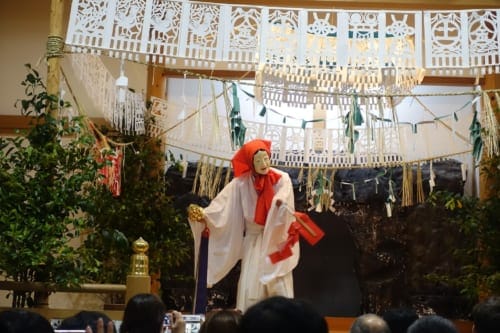
During the third act, Totori’s Dance, you will be surprised by Tajikarao’s red face and the movements of his long black hair as he puts all his strength into breaking down the door to the cave.
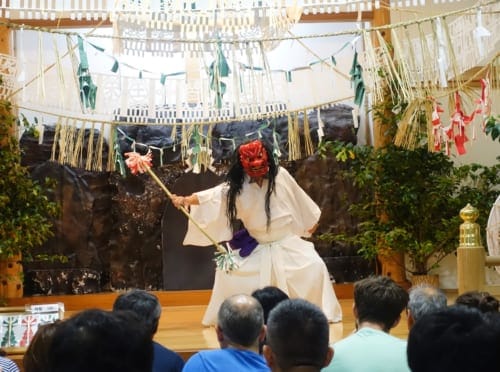
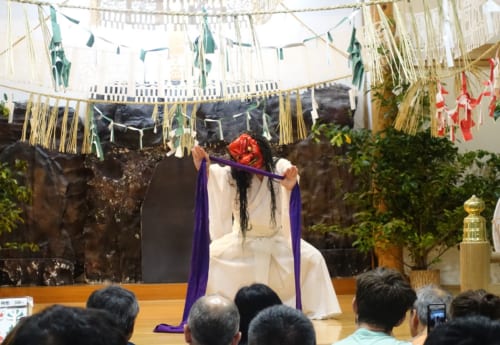
The fourth and final act, Goshintai’s Dance, is the most intense of the performance. It shows a couple preparing rice grains that they offer to the gods while drinking sake. They pray for a happy marriage, fertility and for the prosperity of their future children, as well as a huge harvest. This is a surprising interactive dance; the couple mingles with the crowd to transmit the protection of the deities by hugging some spectators.
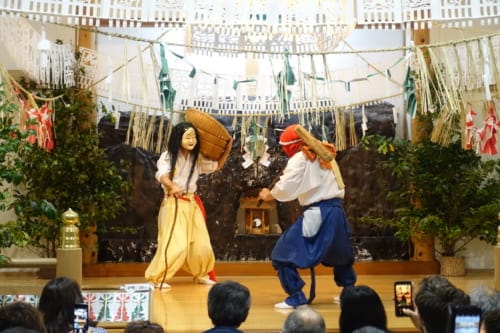
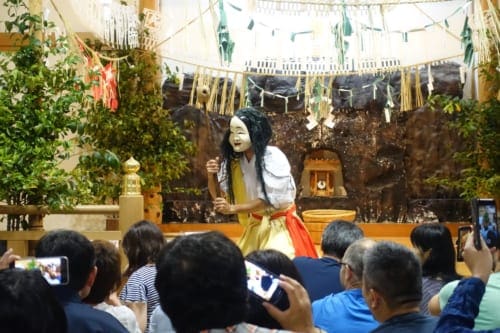
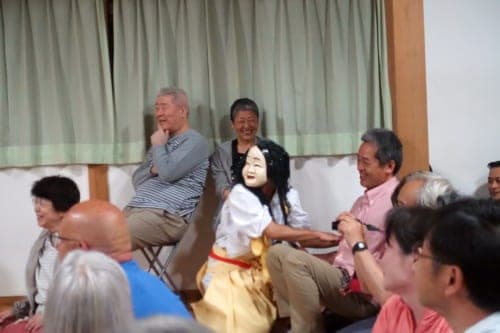
Visit the studio that produces Takachiho Kagura masks called “Omotesama”
If you’re impressed by the expressive Noh masks used in the Kagura, a visit to the traditional craft workshop where they are made is worth a visit. After leaving the main road of Takachiho, you will cross picturesque rice fields before arriving at Amanoiwato Kibori studio (天岩戸木彫工房).
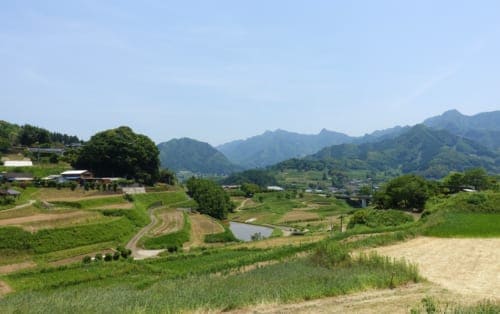
I was welcomed by the master craftsman in the workshop reception area where I admired the kagura masks (Omotesama) displayed in a glass case. Some were finished, painted and glazed, while others were still unfinished and it was possible to see the details carved in the wood. The studio has 3 rooms dedicated to the creation of masks from start to finish. There are 2 traditional Japanese rooms with tatamis, where, seated on the floor, the master craftsman and his son sculpt the shape and expressions of the faces into the wood with the finest details. It is meticulous process which makes it possible to create such elaborate masks.
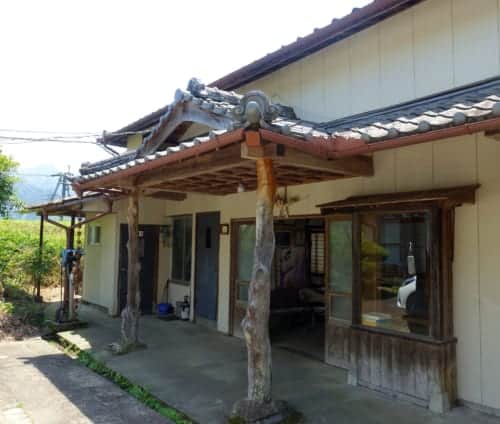
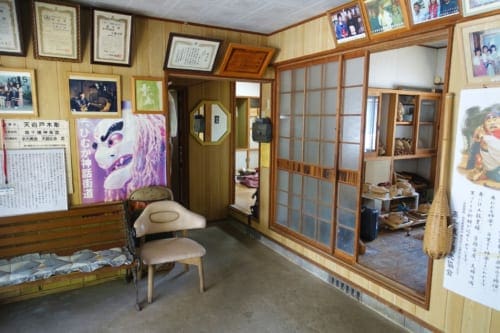
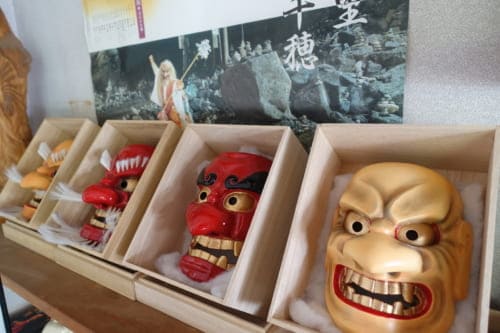
During my visit, the master craftsman was finishing a replica of the mask of the Tajikarao divinity, that will be used in Takachiho’s Kagura Performance. He invited me to sit with him, so I had the pleasure to witness his precise work while chatting about his activity. The floor was covered with wood shavings and the pleasant smell of wood was floating in the room.
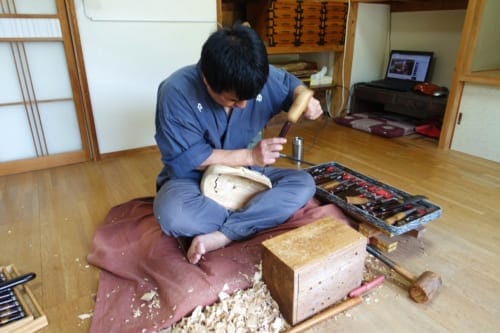
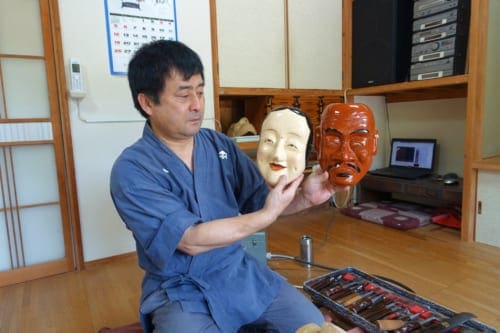
The studio has been producing Kagura masks for more than four generations; the second and third generations are certified traditional crafts by the municipality. Kagura’s masks are carved in camphor and paulownia wood. From cutting timber in the forest to final glazing, all of the creative stages are done in this workshop. The first stage is wood carving and requires on average 2 days, then painting and glazing takes 5 days; in total it takes a full week to make Kagura masks.
Nowadays, certified master craftsmen are very rare in Japan, and therefore Amanoiwato Kibori studio receives orders from all over Japan (mainly for matsuri, Japanese festivals during which Japanese people celebrate the deities).
Note that the master craftsman and his son speak very little English, but they will be able to make you understand their work through their kindness.
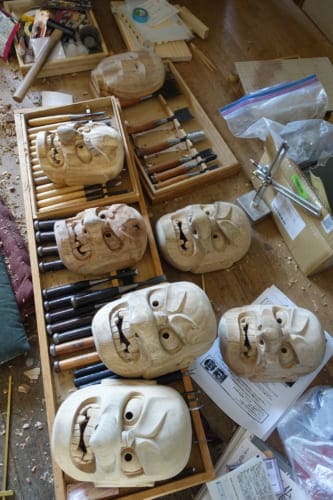
Useful information and access
Takachiho Kagura
Tickets can be bought at the gate, it costs 700 yen per person
Address: Takachiho Shrine, 1037 Mitai, Oaza Takachiho-chō, Nishiusuki-gun, Miyazaki-ken 882-1101
Free parking available
Web link: http://takachiho-kanko.info/en/boat_kagura/#lnk_kagura
AmanoiwatoKibori Workshop 天岩戸木彫工房
Visits available with previous booking
TEL: 0982-74-8901
Address:339 Oazaiwato Takachiho-cho, Nishiusuki-gun, Miyazaki prefecture
宮崎県西臼杵郡高千穂町大字岩戸399番地
Website: http://iwatokibori.com/
Free parking available


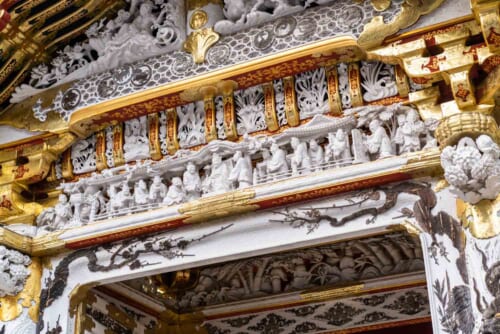
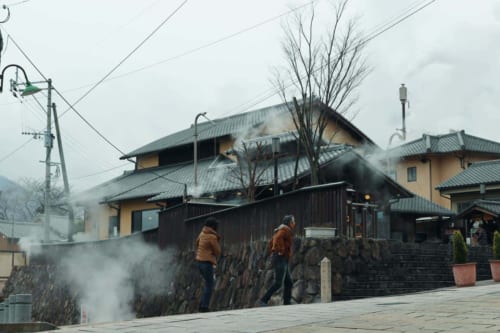
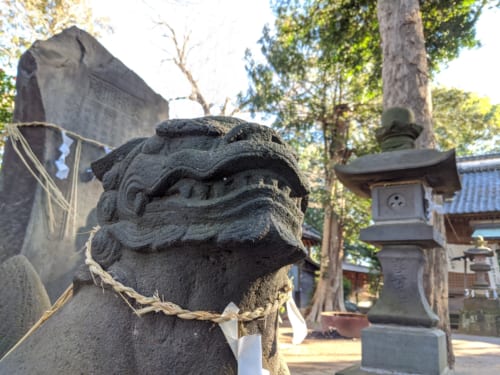

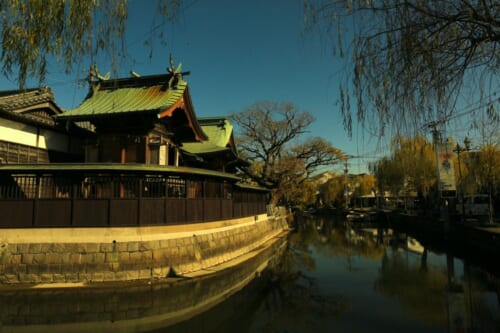
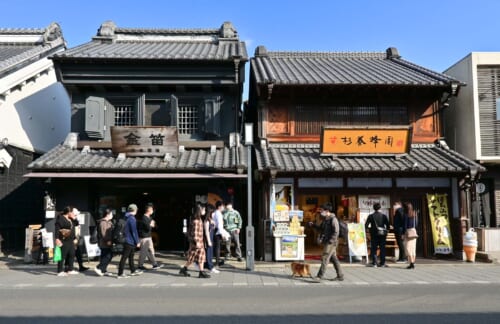


No Comments yet!